change time AUDI A8 2013 User Guide
[x] Cancel search | Manufacturer: AUDI, Model Year: 2013, Model line: A8, Model: AUDI A8 2013Pages: 318, PDF Size: 79.34 MB
Page 123 of 318
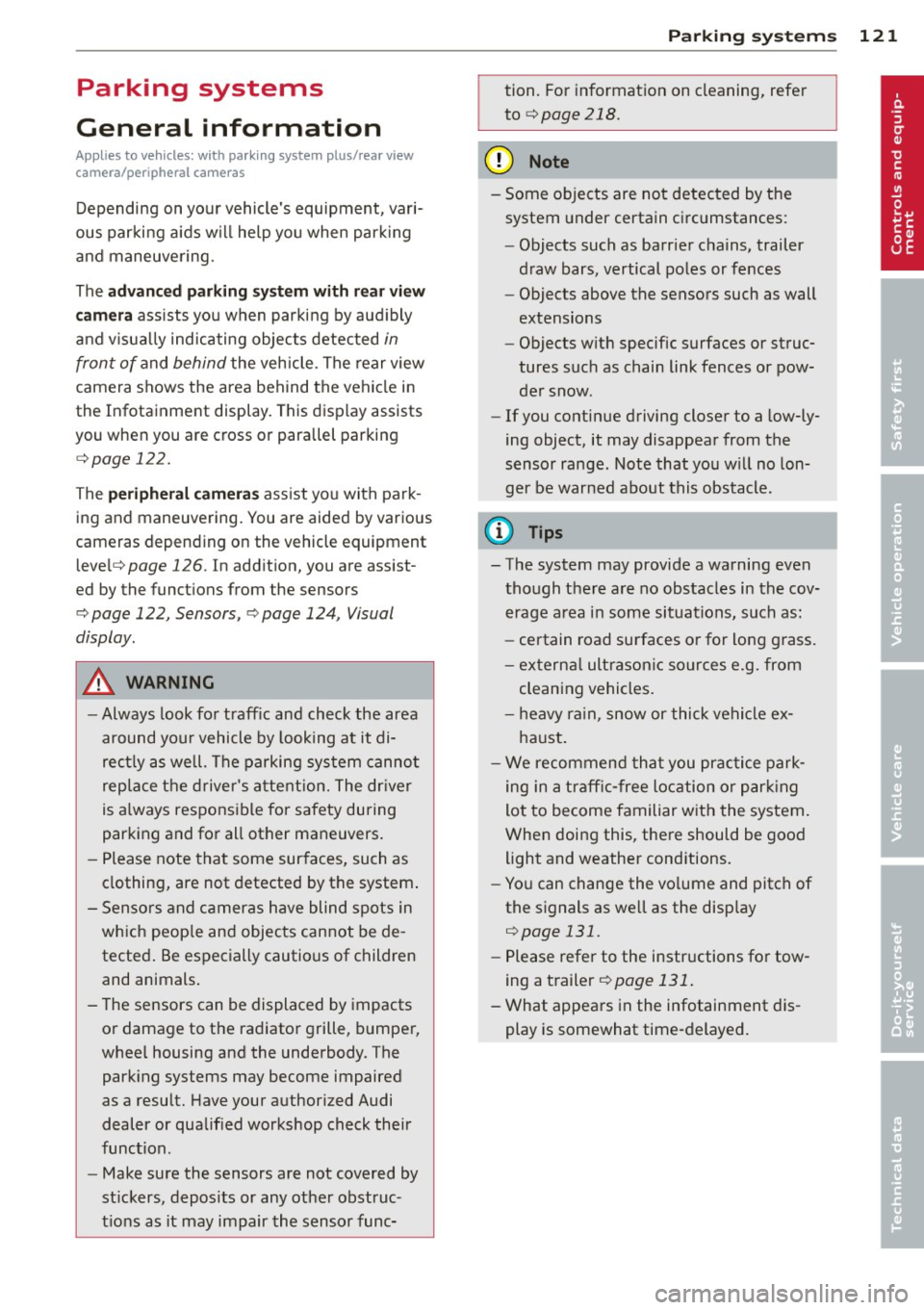
Parking systems
General information
App lies to vehicles: with park in g system plus/rear view
camera/peripheral cameras
Depending on your vehicle's equipment, vari
ous parking aids will help you when parking
and maneuvering.
The
advanced parking system with rear view
camera
ass ists you when parking by audibly
and v isua lly indicating objects detected
in
front of
and behind the vehicle . The rear view
camera shows the area behind the vehicle in
the Infotainment display. This display assists
you when you are cross or para llel parking
c:;,page 122.
The peripheral cameras assist you with park
ing and maneuvering. You are aided by various
cameras depending on the vehicle equipment level ¢
page 126. In addition, you are assist
ed by the functions from the sensors
c:;, page 122, Sensors, c:;, page 124 , Visual
display .
A WARNING
-Always look fo r traff ic and check the area
around your vehicle by looking at it di
rect ly as well. The parking system cannot
replace the driver's attention. The driver
is a lways respons ible for safety during
parking and for all other maneuvers.
- Please note that some sur faces, such as
clothing, are not detected by the system .
- Sensors and cameras have blind spots in
which peop le and objects cannot be de
tected. Be especially cautious of children
and animals.
- The sensors can be displaced by impacts
or damage to the radiator grille, bumper,
wheel housing and the underbody. The
parking systems may become impaired
as a result. Have your authorized Audi
dealer or qualified workshop check their
function.
- Make sure the sensors are not covered by
stickers, deposits or any other obstruc
t ions as it may impair the sensor func-
Parking systems 121
tion. For information on cleaning, refer
to
c:;, page 218.
(D Note
-Some objects are not detected by the
system under certain circumstances:
- Objects such as barr ier chains, trailer
draw bars, vertical poles or fences
- Objects above the sensors such as wall
extensions
- Objects w ith specific surfaces or struc
tures such as chain link fences or pow
der snow .
- If you continue driving closer to a low-ly
ing object, it may disappear from the
sensor range. Note that you w ill no lon
ger be warned about this obstacle .
(D Tips
- The system may provide a warning even
though there are no obstacles in the cov
erage area in some situations, such as:
- certain road surfaces or for long grass.
- externa l ult rason ic so urces e.g. from
cleaning vehicles.
- heavy rain, snow or thick vehicle ex
haust.
- We recommend that you practice park
ing in a traffic-free location or parking
lot to become familiar w ith the system.
When doing this, there should be good
light and weather cond itions.
- You can change the volume and pitch of
the signals as we ll as the disp lay
c:;, page 131.
-Please refer to the instructions for tow
ing a trailer
c:;, page 131.
- What appears in the infotainment dis
play is somewhat time-delayed.
Page 152 of 318
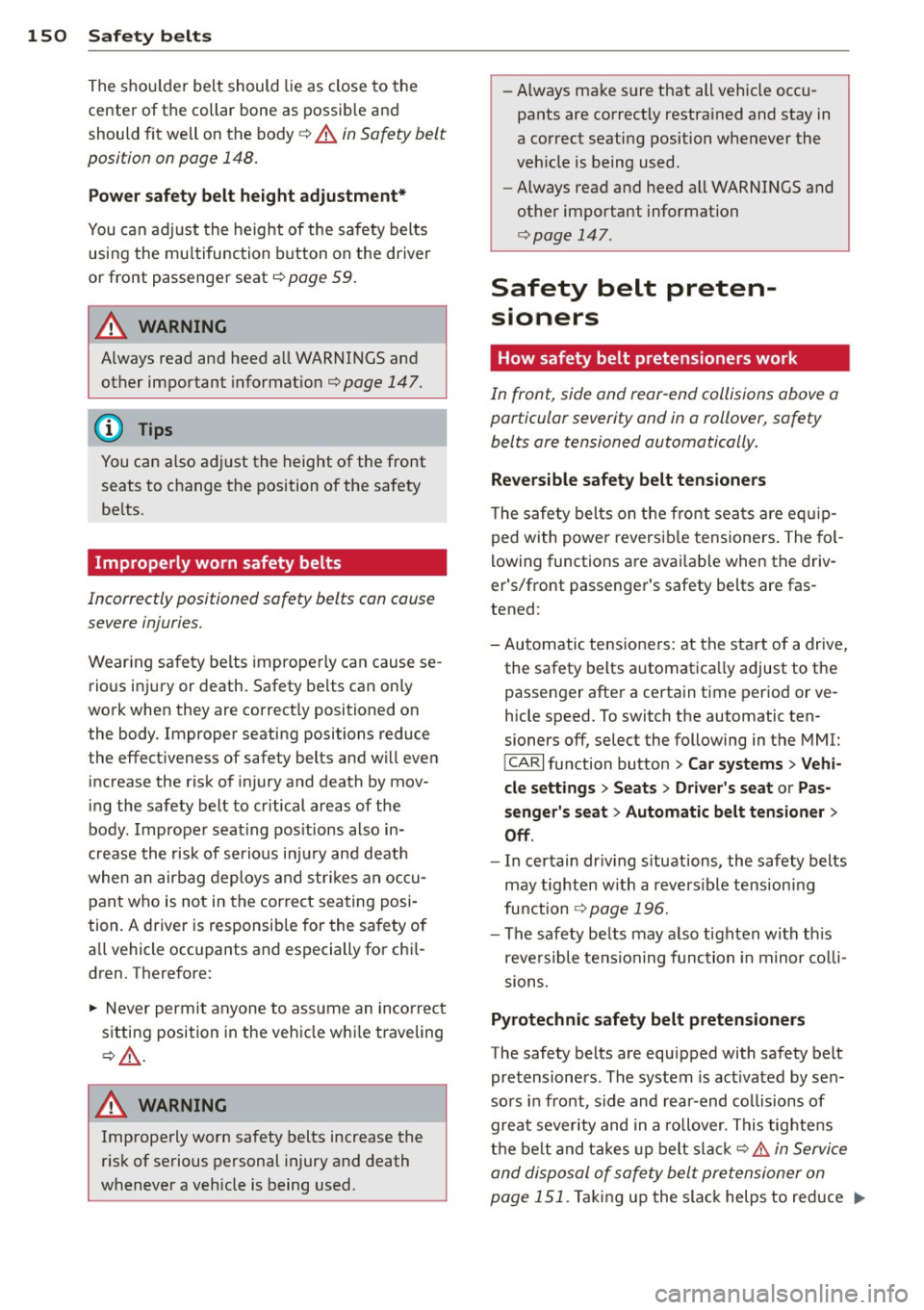
150 Safety belts
The s hou lder belt should lie as close to the
center of the collar bone as possib le and
should fit well on the body¢
A in Safety belt
position on page 148.
P ower saf ety belt h eight adju stment *
You can ad just the height of the safety belts
using the mu ltifunction button on the driver
or front passenge r seat ¢
page 59.
A WARNING
Always read and heed all WARNINGS and
other important informat ion¢
page 147.
You can also adjust the height of the front
seats to change the position of the safety
be lts.
Improperly worn safety belts
Incorrectly positioned safety belts can cause
severe injuries.
Wear ing safety be lts imprope rly can cause se
rio us inj ury or death. Safety be lts can on ly
wo rk when they are correct ly positioned on
the body. Improper seating positions reduce
the effect iveness of safety belts and will even
increase the r isk of injury and death by mov
ing the safety belt to cr itical areas of the
body. Imprope r seat ing pos it ions also in
crease the risk of serious in jury and death
when an air bag deploys and str ikes a n occu
pant who is not in the correct seating posi
tion . A driver is responsib le for the sa fety of
all vehicle occupants and especially for chi l
dren. Therefore:
~ Never permit anyone to ass ume an incorrect
sitting position in the vehicle w hile traveling
¢&_ .
A WARNING
Imprope rly worn safety belts increase the
r isk of serious personal injury and death
whenever a veh icle is being used. -
Always make sure that all vehicle occu
pants are correctly restrained and stay in
a correct seating position whenever the
veh icle is being used .
- Always read and heed all WAR NINGS and
other important information
¢ page 147.
Safety belt preten
sioners
How safety belt pretensioners work
In front, side and rear -end collisions above a
particular severity and in a rollover , safety
belts are tensioned automatically.
Reversible safety belt tensioners
T he safety belts on the fro nt sea ts ar e e qui p
ped with powe r reversib le tensioners . The fo l
lowing functions a re ava ilab le when the driv
er's/front passenger's safety belts are fas
tened :
- Automatic tens ioners : at the start of a drive,
the safety belts automat ica lly adjust to the
passenger after a certain time period or ve
hicle speed. To switch the automatic ten
sioners off, select the following in the MMI:
! CARI function button> Car systems > Vehi
cle settings > Seats > Driver's seat or Pas
s enger's seat
> Automatic belt t ensioner >
Off .
-In certain dr iv ing s ituations, the safety belts
may tighten w ith a revers ible tens ion ing
fu nction
¢ page 196.
-The safety be lts may a lso t ighten with th is
reve rsible tensioning function in minor co lli
sion s.
Pyrotechnic safety belt pretensioners
The safety belts are equ ipped with safety belt
pretensioners . The system is act ivated by se n
sors i n front, s ide and rear-end co llisions of
great severity and in a rollover. This tig htens
t h e belt and t akes up belt slack¢.&.
in Service
and disposal of safety belt pretensi oner on
page 151.
Taking up the slack helps to reduce 1111>
Page 200 of 318
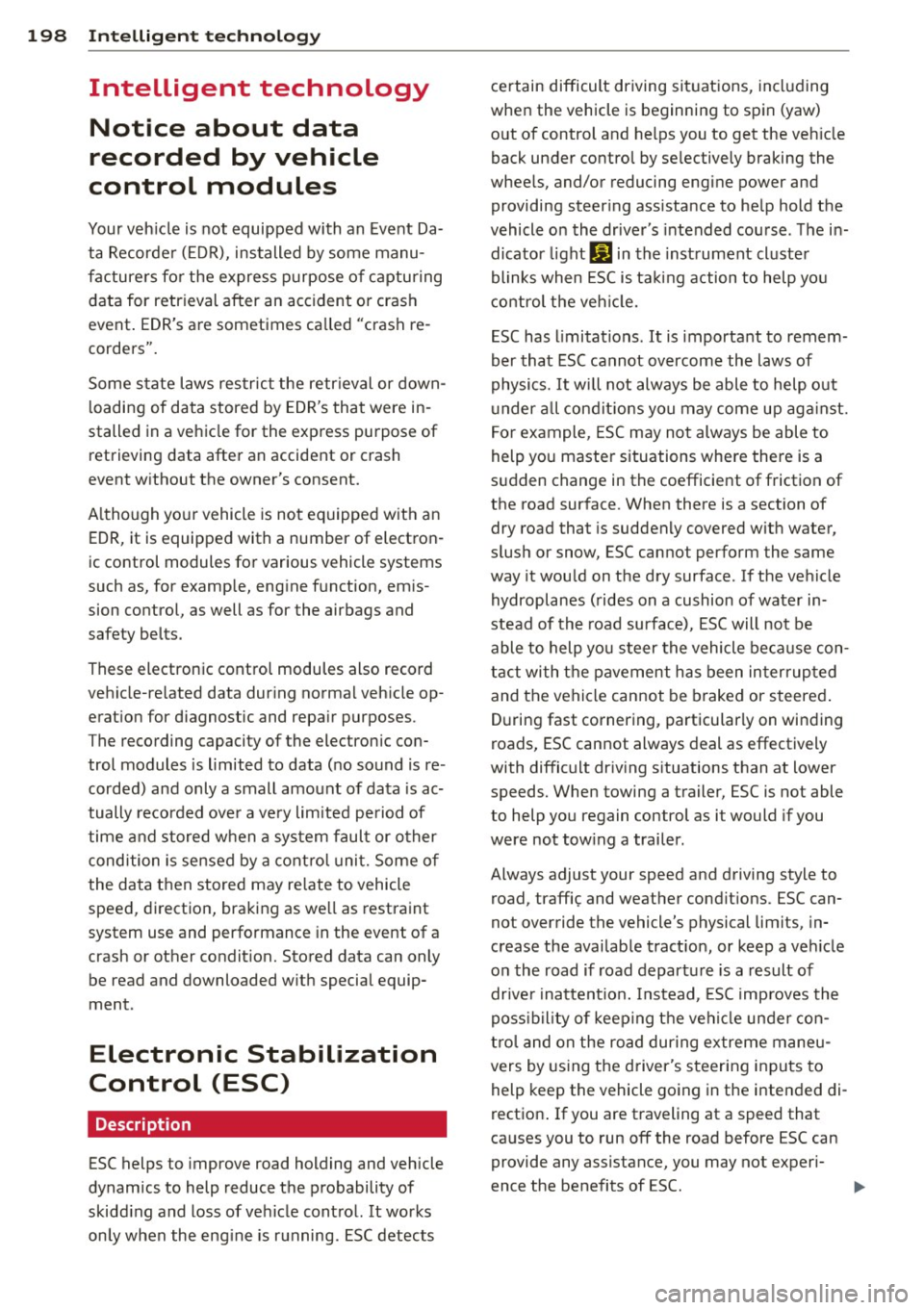
198 Intellige nt tec hno logy
Intelligent technology
Notice about data
recorded by veh ic le
control modules
Your vehicle is not equipped with an Event Da
ta Recorder (EDR), installed by some manu
facturers fo r the express purpose of capturing
data for retrieval after an accident or crash
event . EDR's are sometimes called "crash re
corders".
Some state laws restrict the retrieval or down
loading of data stored by EDR's that were in
stalled in a vehicle for the express purpose of
retrieving data after an accident or crash
event without the owner's consent.
A lthough your vehicle is not equipped with an
EDR, it is equipped with a number of electron
ic control modules for various vehicle systems
such as, for example, engine function, emis
sion control, as well as for the airbags and
safety belts.
These electronic control modules also record
vehicle-related data during normal vehicle op
eration for diagnostic and repair purposes.
The recording capacity of the electronic con
trol modules is limited to data (no sound is re
corded) and only a small amount of data is ac
tually recorded over a very limited period of
time and stored when a system fault or other
condition is sensed by a control unit. Some of
the data then stored may relate to vehicle
speed, direction, braking as well as restraint
system use and performance in the event of a
crash or other condition. Stored data can only
be read and downloaded with special equip
ment.
Electronic Stab ilization
Control (ESC)
Description
ESC helps to improve road holding and vehicle
dynamics to help reduce the probability of
skidding and loss of vehicle control. It works
only when the engine is running. ESC detects certain difficult driving situations, including
when the vehicle is beginning to spin (yaw)
out of control and helps you to get the vehicle back under control by selectively braking the
wheels, and/or reducing engine power and
providing steering assistance to help hold the
vehicle on the driver's intended course. The in
dicator light
G) in the instrument cluster
blinks when ESC is taking action to help you
control the vehicle.
ESC has limitations.
It is important to remem
ber that ESC cannot overcome the laws of
physics. It will not always be able to help out
under a ll cond itions you may come up against.
For example, ESC may not always be able to
help you master situations where there is a
sudden change in the coefficient of friction of
the road surface. When there is a section of
dry road that is suddenly covered with water,
slush or snow, ESC cannot perform the same
way it would on the dry surface . If the vehicle
hydroplanes (rides on a cushion of water in
stead of the road surface), ESC will not be
able to help you steer the vehicle because con
tact with the pavement has been interrupted
and the vehicle cannot be braked or steered.
During fast cornering, particularly on winding
roads, ESC cannot always deal as effectively
with difficult driving situations than at lower
speeds. When towing a trailer, ESC is not able
to help you regain control as it would if you
were not towing a trailer.
Always adjust your speed and driving style to road, traffic; and weather conditions. ESC can
not override the vehicle's physical limits, in
crease the available traction, or keep a vehicle
on the road if road departure is a result of
driver inattent ion. Instead, ESC improves the
possibility of keeping the vehicle under con
trol and on the road during extreme maneu
vers by using the driver's steering inputs to
help keep the vehicle going in the intended di
rection . If you are traveling at a speed that
causes you to run off the road before ESC can
provide any assistance, you may not experi
ence the benefits of ESC.
Page 201 of 318
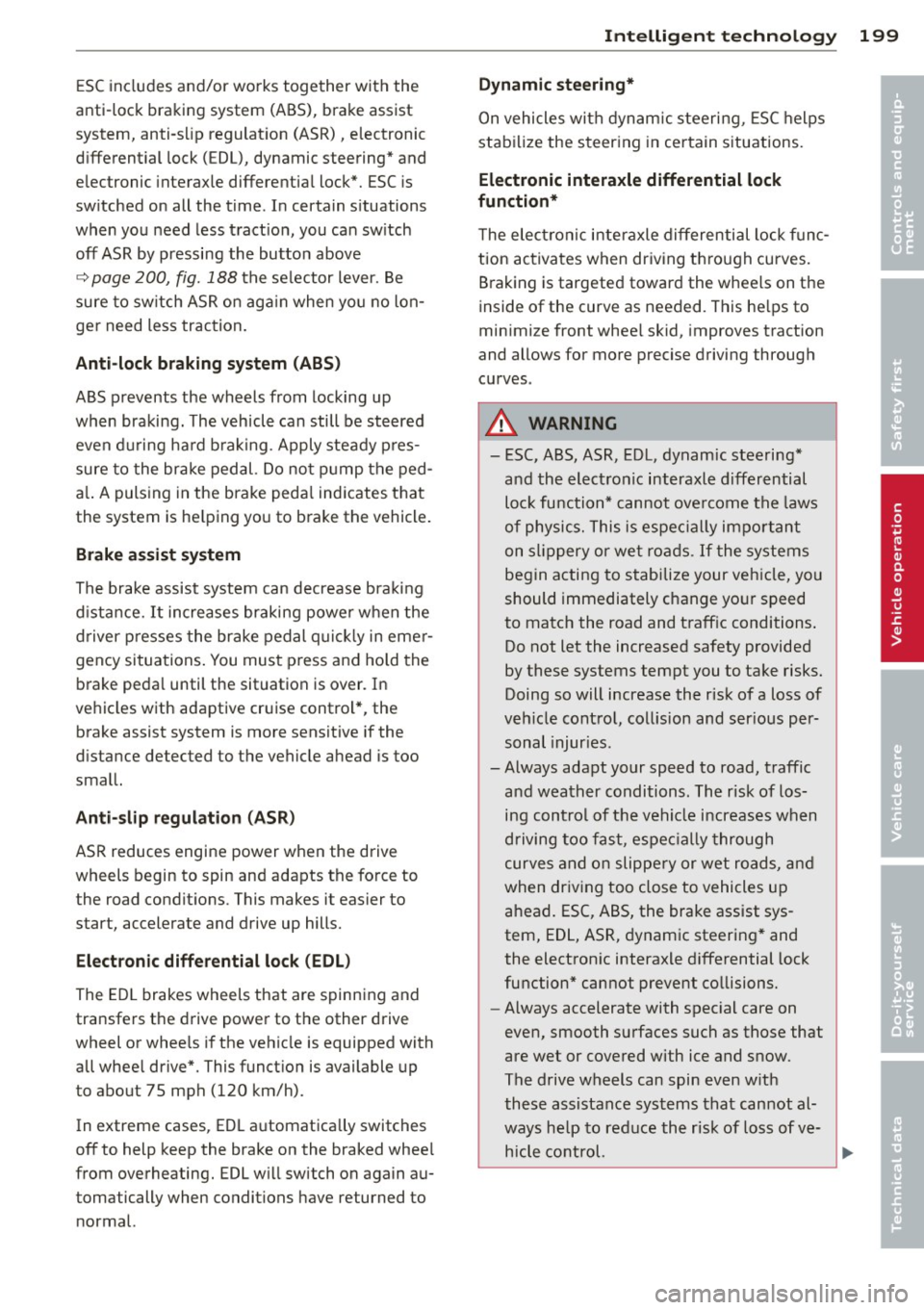
ESC includes and/or works together with the
anti-lock braking system (ABS), brake assist
system, anti-s lip regulat ion (ASR), electronic
d ifferential lock (EDL), dynamic steering* and
electronic interaxle differential lock*. ESC is
sw itched on all the time . In certain s ituations
when you need less tract ion, you can sw itch
off ASR by pressing the button above
~ page 200, fig. 188 the se lector lever. Be
sure to sw itch ASR o n aga in when yo u no lon
ger need less traction.
Anti -lock braking system (ABS)
ABS prevents the wheels from locking up
when braking. The veh icle can still be steered
even du ring ha rd b raking . Apply steady p res
sure to the brake pedal. Do not p ump the ped
a l. A pulsing in the brake peda l indicates that
the system is he lping you to brake the vehicle .
Brake as sist system
The brake assist system can decrease bra king
d istance.
It increases braking power when the
driver presses the brake pedal qu ick ly in eme r
gency situations . You must p ress and ho ld the
brake peda l until the situation is over. In
vehicles with adaptive cruise control*, the
brake assist system is more sensit ive if the
d istance detected to the vehicle ahead is too
small.
Anti- slip regulati on (A SR )
ASR reduces engine power when the drive
wheels begin to spin and adapts the force to the road condit ions. This makes it eas ier to
start, accelerate and drive up hills.
Electronic diff erential lo ck (EDL )
The ED L brakes wheels that are spinning and
transfers the drive power to the other drive
wheel or whee ls if the vehicle is equipped with
all whee l drive*. This funct ion is available up
to about 75 mph (120 km/h).
In extreme cases, EDL automatica lly switches
off to help keep the brake on the braked whee l
from overheating. EDL w ill switch on again au
tomatically when conditions have returned to normal.
Int ellig ent technolog y 199
Dynamic ste ering *
On vehicles with dynam ic steering, ESC helps
stabilize the steering in certain situations.
Electronic intera xle differential l ock
function*
T he electron ic i nteraxle differential lock f unc
tion activa tes when dr iving th ro ugh curves.
Braking is targeted toward the wheels on the
inside of the curve as needed. This he lps to
minimize front whee l skid, improves traction
and allows for more precise driving through curves .
A WARNING
- ESC, ABS, ASR, EDL, dynamic steering*
and the elect ronic interaxle differential
loc k function* cannot ove rcome the laws
of physics. This is espec ially important
on slippery or we t roads.
If the systems
begin acting to stabilize your veh icle, you
should immediately change yo ur speed
to match the road and traffic conditions .
Do not let the increased safety provided
by these systems tempt you to take risks.
Doing so will increase the risk of a loss of
veh icle contro l, collision and ser ious per
sonal injur ies.
- Always adapt your speed to road, traffic and weather conditions. The risk of losing con trol of the vehicle increases when
driving too fast, espe cially through
curves a nd on slippe ry or wet roads, and
when dr iving too close to vehicles up
ahead. ESC, ABS, the brake assist sys
tem, EDL, ASR, dynam ic steering* and
the electron ic interaxle d ifferential lock
function" cannot prevent co llisions.
- Always accelerate with spec ial care on
even, smooth surfaces such as those that
are wet or covered with ice and snow.
The drive wheels can spin even w ith
these assistance systems that cannot al
ways he lp to red uce the risk of loss of ve
hicle control.
-
•
•
Page 231 of 318
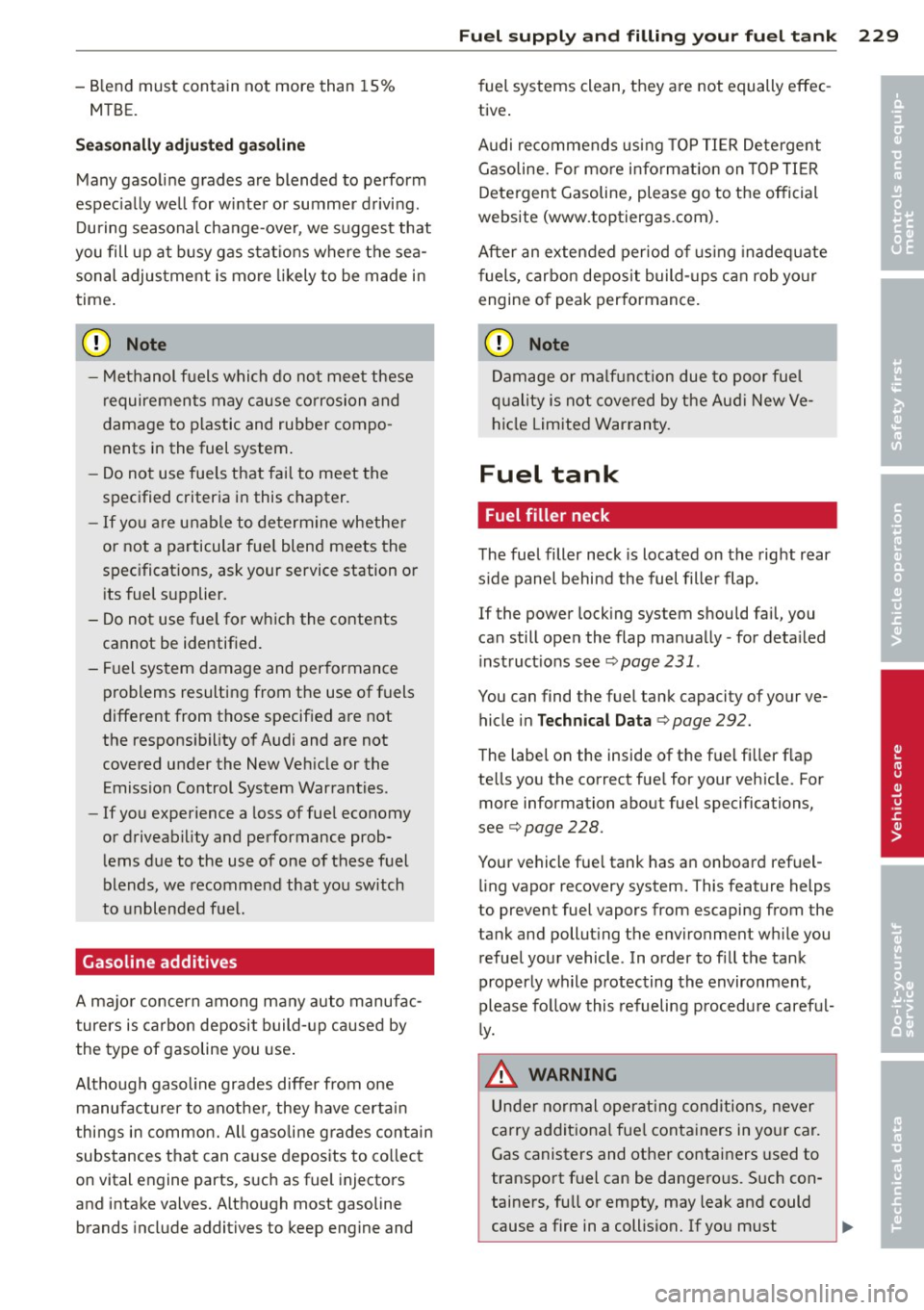
-Blend must contain not more than 15%
MTBE.
Seasonally adjusted gasoline
Many gasoline grades are blended to perform
espec ially we ll for winter or summer driving.
During seasonal change-over, we suggest that
you fill up at busy gas stat ions where the sea
sonal adjustment is more likely to be made in
time .
(D Note
-Methanol fuels which do not meet these
requirements may cause corrosion and
damage to plastic and rubber compo
nents in the fuel system .
- Do not use fue ls that fail to meet the
specified criter ia in this chapter.
- If you are unable to determine whether
or not a particular fue l blend meets the
specifications, ask your service station or
its fuel supp lier.
- Do not use fuel for which the contents
cannot be identified.
- Fuel system damage and performance
problems resulting from the use of fuels
different from those specified are not
the responsibility of Audi and are not
covered under the New Vehicle or the Emission Control System Warranties.
- If you experience a loss of fuel economy
or driveability and performance prob l ems due to the use of one of these fuel
blends, we recommend that you switch
to unblended fuel.
Gasoline additives
A major concern among many auto manufac
turers is carbon deposit build- up caused by
the type of gasoline you use.
Although gasoline grades differ from one manufacturer to another , they have certain
things in common. All gasoline grades contain
substances that can cause deposits to collect
on vital engine parts, such as fuel injectors
and intake valves. Although most gasoline brands include additives to keep engine and
Fuel supply and filling your fuel tank 229
fuel systems clean, they are not equally effec
tive .
A udi recommends using TOP TIER Detergent
Gasoline. For more info rmation on TOP TIER
Detergent Gasoline, please go to the official
website (www.toptiergas.com).
After an extended period of using inadeq uate
fuels, carbon deposit build-ups can rob your
engine of peak performance.
Q) Note
Damage or malf unct ion due to poor fue l
quality is not covered by the Aud i New Ve
hicle Limited Warranty.
Fuel tank
Fuel filler neck
The fuel filler neck is located on the right rear
side panel behind the fuel fille r flap.
If the power locking system should fail, you
can still open the flap manually -for deta iled
instruct ions see ¢
page 231.
You can find the fuel tank capacity of your ve
hicle in
Technical Data ¢ page 292.
The label on the inside of the fuel fi ller flap
tells you the correct fue l for your vehicle. For
more information about fuel specifications,
see ¢
page 228.
Your vehicle fue l tank has an on board refuel
li ng vapor recovery system. This feature helps
to prevent fuel vapors from escaping from the
tank and polluting the environment while you refuel your vehicle . In order to fill the tank
properly while protecting the environment,
please fo llow this refueling procedure careful
ly.
_&. WARNING
Under normal operating conditions, never
carry additional fuel containers in your car.
Gas canisters and other containers used to
transport f uel can be dangero us. Such con
tainers, full or empty, may leak and could
cause a fire in a collision. If you must
•
•
Page 238 of 318
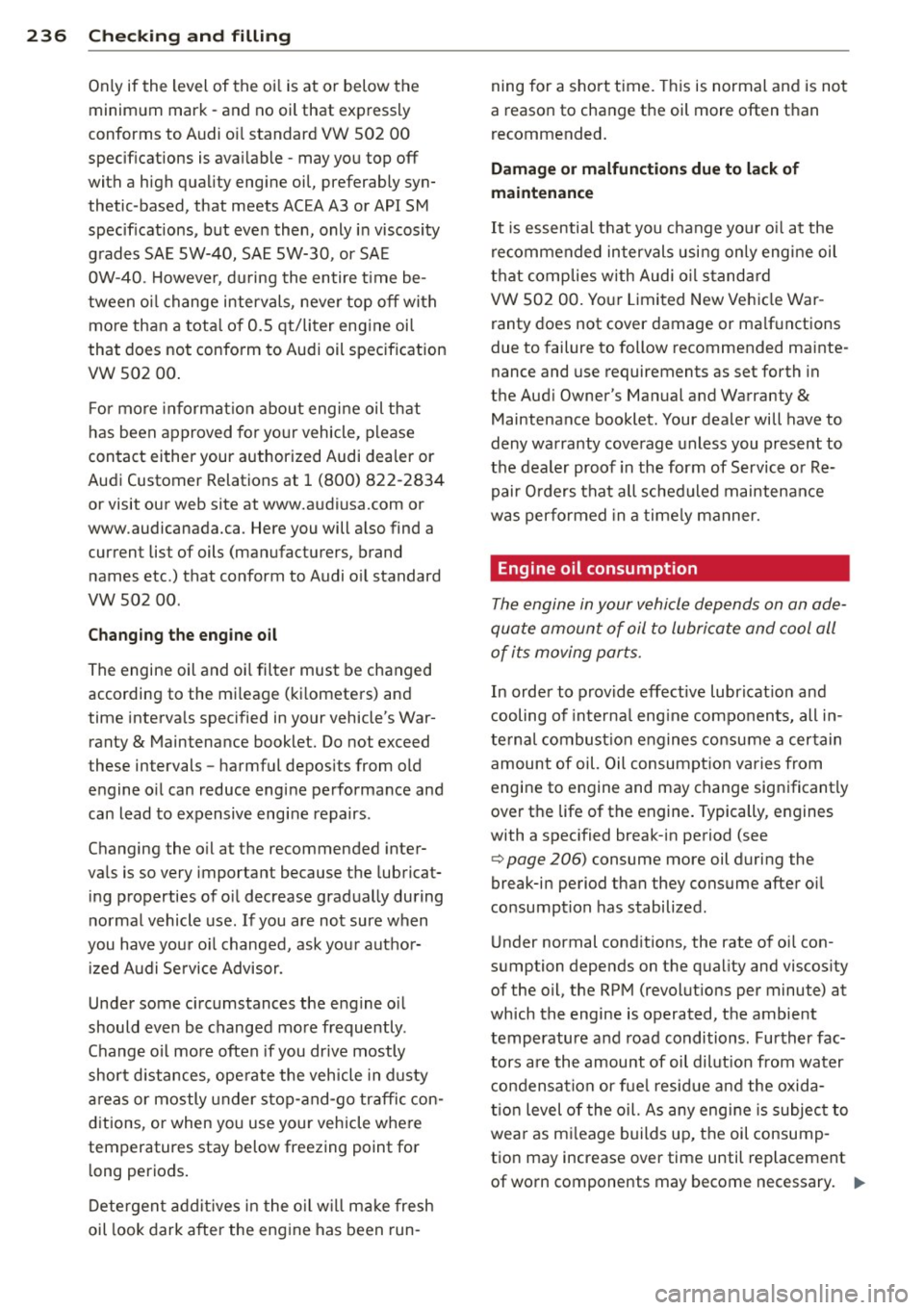
236 Check ing and filling
Only if the level of the oi l is at or below the
minimum mark -and no oil that expressly
conforms to Audi o il standard VW 502 00
specifications is ava ilable - may you top off
with a high quality eng ine oil, preferably syn
thetic -based, that meets AC EA A3 or API SM
specif ications, but even then, only in viscos ity
grad es SAE SW-40, SA E SW-30 , or SAE
OW-40. Howeve r, during the en tire t ime be
tween oi l change intervals, never top off with
more than a tota l of 0.5 qt/liter eng ine oi l
that does not conform to Audi oil specification
vw 502 00 .
F or more informa tion about engine oil that
has been approved for yo ur vehicle , please
contact either your authorized Audi dealer or
Audi Customer Relations at 1 (800) 822-2834
or visit our web site at www.audiusa.com or
www.audicanada.ca . Here you will a lso find a
current list o f oils (manufacturers, brand
names etc .) that conform to Audi o il standard
vw 502 00.
Chang ing the engine oil
The engine oil and oi l filter must be changed
according to the m ileage (ki lometers) and
time interva ls specified in your vehicle's War
ranty
& Maintenance booklet. Do not exceed
these in tervals -harmful depos it s from old
engine o il can reduce engine performance and
can lead to expensive eng ine repairs .
Changing the o il at the recommended inter
va ls is so very important because the lubricat
ing p roperties of o il decrease gradually during
norma l vehicle use. If you are not sure when
you have you r o il changed, ask you r autho r
iz ed Audi Service Advisor.
Under some c ircumstances the engine o il
should even be changed more frequently .
Change oi l mo re often if you drive mostly
short d istances , ope rate the vehicle in dusty
a reas or mostly under s top-and-go tr affic con
d itions , or when yo u use your vehicle whe re
temperatures stay below freezing point for l ong periods .
D etergen t add itives in the o il w ill mak e fresh
oil look dark after the eng ine has been run- ning for a sho
rt time. This is normal and is not
a reason to change the oil more often than
recommended.
Damage or malfunctions due to l ack of
maintenance
It is essentia l th at you c hange yo ur oil at the
r ecommended intervals usi ng on ly eng ine oil
that comp lies with Audi oi l standa rd
VW 502 00. You r Limited New Vehicle War
r anty does not cover damage or ma lf u nctions
due to failure to follow recommended ma inte
nance and use requirements as set forth in
the Aud i Owner's Manual and Warranty
&
Maintenance booklet. Your dealer will have to
deny warranty coverage unless you present to
the dealer proof in the form of Service o r Re
pair Orders that all scheduled maintenan ce
w as performed in a time ly m anner.
Engine oil consumption
The engine in your vehicle depends on an ade
quate amount of oil to lubri cate and
cool all
of its moving por ts .
In order to p rovide effective lubricat ion and
c ooling of inte rna l eng ine compo nents, all i n
tern al combust ion engines co nsume a cer tain
amount of oil. Oil consumpt ion varies from
engine to engine and may change significantly
over the life of the engine . Typically , engines
with a spec ified break-in period (see
¢ page 206) consume more oil duri ng the
break-i n period than they consume after o il
consumption has stabilized .
Under normal cond itions , the rate of oi l con
s u mption depends on the q uality and viscos ity
of the oil, the RPM (revolut ions per minu te) at
which the engine is operated, the ambient
temperature and road conditions. Further fac
tors a re the amount of oil dilut ion from water
c o ndensa tion or fue l resid ue a nd the oxida -
t ion level of the oil. As any engine is subjec t to
wea r as m ileage b uilds up, the oil consump-
tion may increase over time until replacement of wo rn components may become necessary. ..,..
Page 241 of 318
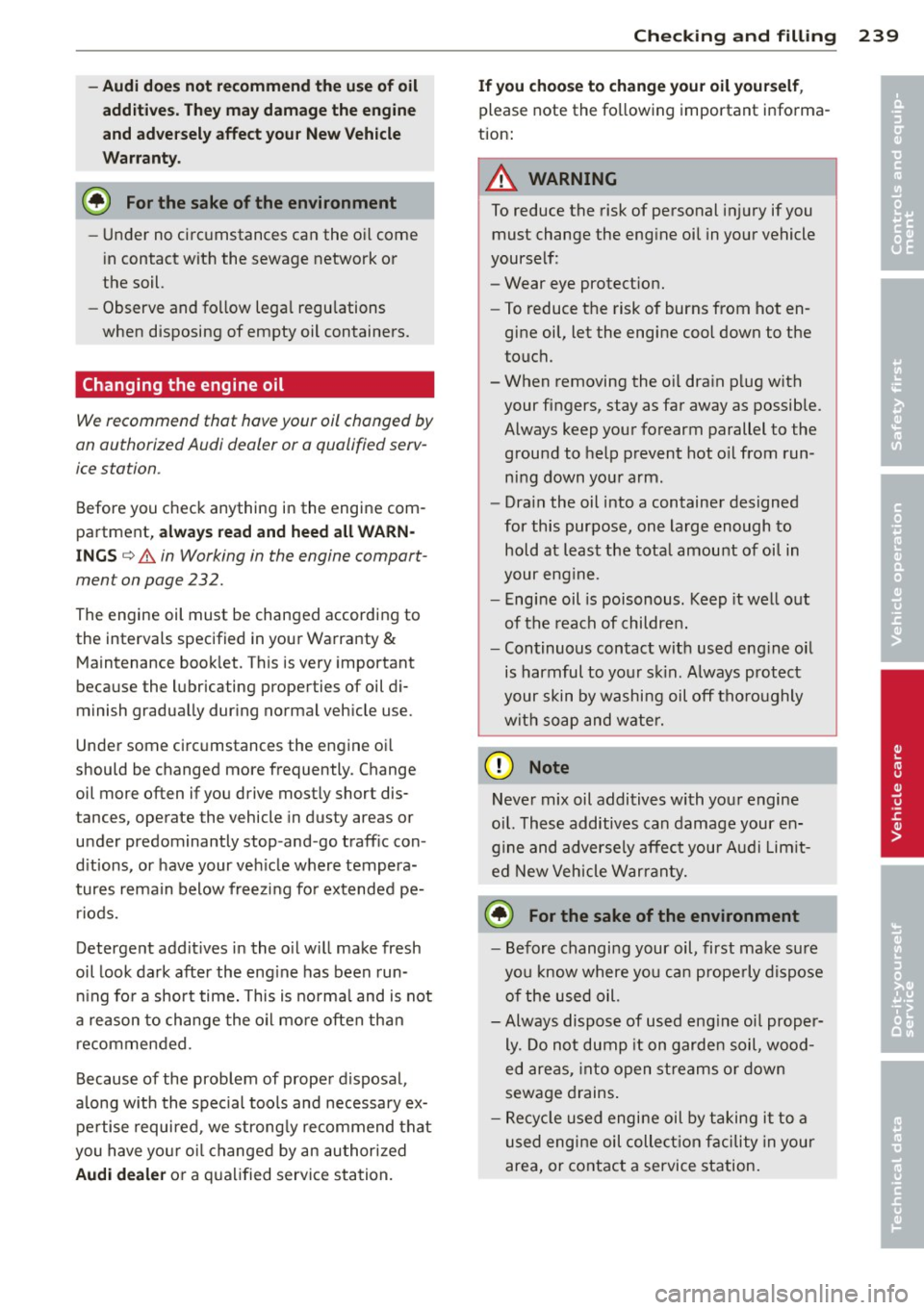
-Audi doe s not recommend the use of oil
add iti ve s. T he y ma y damage the engine
and ad ve rse ly affect you r New Vehicle
Wa rrant y.
@ For the sake of the environment
- Under no circumstances can the oil come
in contact with the sewage network or
the soil.
- Observe and follow lega l regu lations
when disposing of empty oil containers.
Changing the engine oil
We recommend that hove your oil changed by
on authorized Audi dealer or a qualified serv
ice station .
Before you check anything in the engine com
partment,
a lw ays r ead and heed all WARN
ING S
c:> &. in Working in the engine comport
ment on page 232.
The engine oil must be changed according to
the intervals specified in your Warranty
&
Maintenance booklet. This is very important
because the lubricating properties of oil di
minish gradually dur ing normal veh icle use.
Under some circumstances the engine oil
should be changed more frequently. Change
oil more often if you drive mostly short dis
tances, operate the vehicle in dusty areas or
under predominantly stop-and -go traff ic con
d itions, or have your veh icle where tempera
tures remain below freezing fo r extended pe
r iods.
Detergent additives in the o il w ill make fresh
oil look dark after the eng ine has been run
n ing fo r a short time. This is norma l and is not
a reason to change the oi l mo re often than
recommended.
Because of the problem of proper disposal,
along w ith the special tools and necessary ex
pe rtise required, we strong ly recommend that
you have your oi l changed by an author ized
A udi dealer or a qualified service station.
Checkin g and fillin g 239
If yo u choose to change you r oil yo urs elf ,
please note the fo llowing important informa
tion:
_& WARNING
To reduce the risk of personal injury if you
must change the engine oil in your vehicle
yourself:
- Wear eye protect ion.
- To reduce the risk of burns from hot en-
gine oil, let the engine cool down to the
touch.
- When removing the oi l dra in p lug with
your fingers, stay as far away as possible.
Always keep your forearm parallel to the
grou nd to help prevent hot o il from run
ning down you r arm.
- Dra in the oil into a container designed
for this purpose, one large enough to hold at least the tota l amount of oil in
your engine.
- Engine oil is poisonous. Keep it well o ut
of the reach of children.
- Continuous contact with used eng ine o il
is harmful to yo ur skin . A lways protect
your skin by washing oil off tho roughly
w it h soap and w ater.
d) Note
N eve r mix oil additives with your engine
oil. These additives can damage your en
g ine and adversely affect your Audi Lim it
ed New Vehicle Warranty.
@ For the sake of the environment
- Before changi ng your oil, first make sure
you know where you ca n prope rly dispose
of the used oil.
- Always dispose of used eng ine oi l proper
ly. Do not dump it on garde n soil, wood
ed areas, into open streams or down
sewage drains .
- Recycle u sed engi ne oil by taking it to a
used eng ine oil colle ct ion facility in your
area, or contact a service station.
•
•
Page 245 of 318
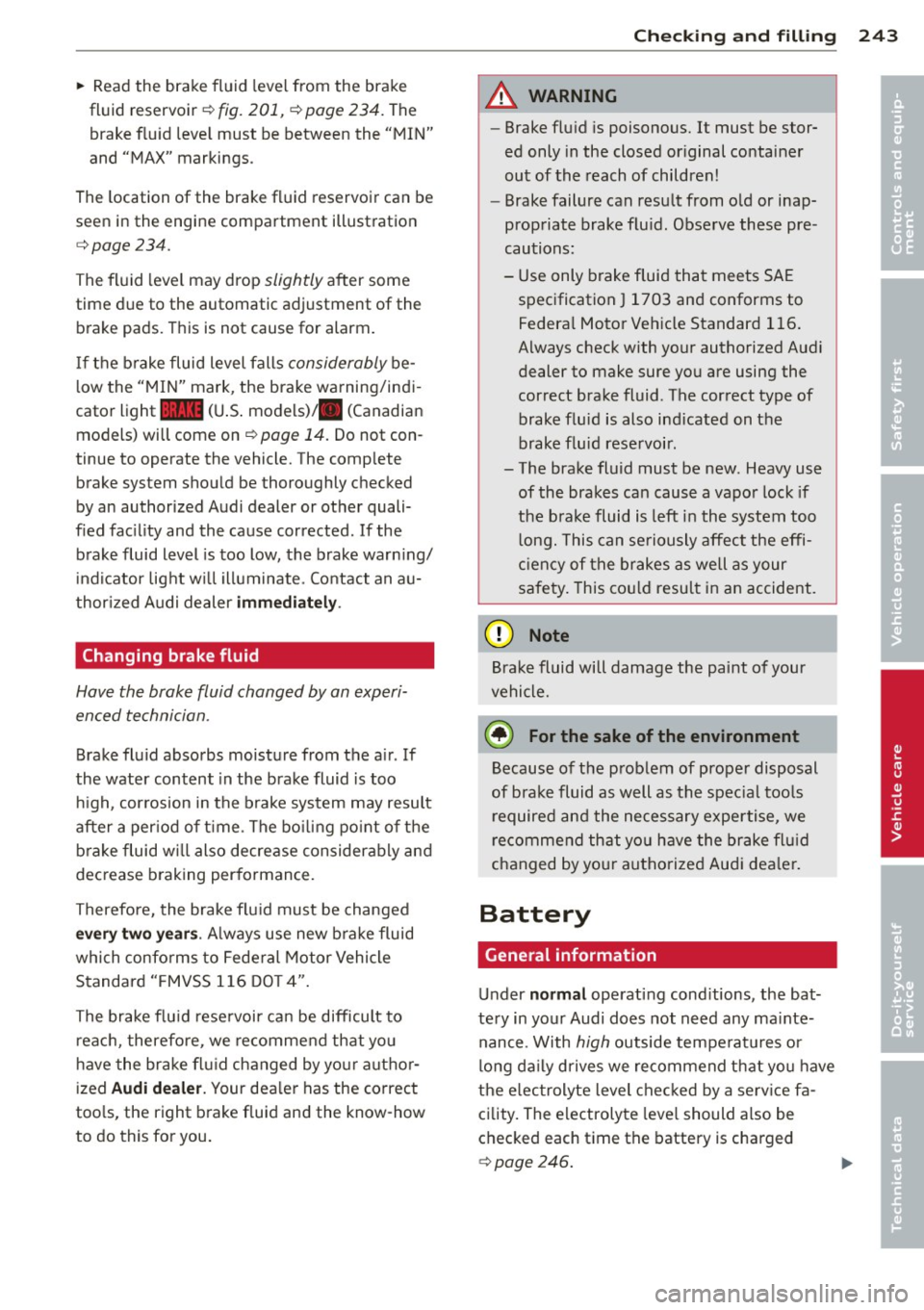
~ Read the brake fluid level from the brake
fluid reservoir ¢
fig. 201, ¢ page 234. The
brake f luid leve l must be between the "MIN"
and "MAX" markings.
The location of the brake fl uid reservoir can be
seen in the engine compartment illustration
¢page 234.
The fluid level may drop slightly after some
time due to the automatic adjustment of the brake pads . This is not cause for alarm .
If the brake fluid level falls considerably be
l ow the " MIN" mark, the bra ke wa rning/indi
cator light
1111 (U .S . models)/ . (Canadian
models) will come on
¢ page 14. Do not con
tinue to operate the vehicle. The comp lete
brake system shou ld be thoroughly checked
by an authorized Audi dealer or other quali
f ied fac ility and the cause corrected. If the
b rake fluid level is too low, the brake warn ing/
i ndicator light w ill illuminate . Co ntact an au
thor ized Audi dealer
immediately .
Changing brake fluid
Have the brake fluid changed by an experi
enced technician .
Brake fluid abso rbs moistu re from the a ir . If
the water content in the brake fluid is too
h igh, cor ros ion in the b rake system may result
after a per iod of t ime . The bo iling po int of t he
b ra ke fluid w ill also decrease considerab ly and
decrease braking performance.
Therefore, the brake flu id must be changed
e very two year s. Always use new b rake fluid
which confo rms to Fede ral Motor Vehicle
Standard "FMVSS 1 16 DOT 4".
The brake flu id rese rvoi r ca n be difficult to
r eac h, therefo re , we re commend that yo u
h ave the brake fl uid changed by you r autho r
i zed
Audi dealer . Your deale r has the correct
too ls, the right brake fluid and the know-how
to do this fo r you .
Checkin g and fillin g 243
A WARNING
-Brake flu id is poisonous. It must be stor
ed only in the closed original co ntainer
out of the reach of children!
- Brake failure can resu lt from o ld or inap
prop riate brake f lu id . Observe these pre
cau tions:
- Use only brake fluid tha t meets SA E
s p ecification
J 1703 an d conforms to
Federa l Moto r Ve hicle Standard 116.
Always check with your authorized Audi
dealer to make sure yo u are using the
correct brake fluid. The cor rect type of
brake f lu id is also ind icated on the
brake flu id rese rvoir .
- The brake fluid must be new . Heavy use
of the brakes ca n cause a vapo r lock if
the b ra ke fluid is left i n the system too
l ong. This can se riou sly affect the effi
c ien cy of the brakes as well as your
safe ty. This co uld resu lt in an accident.
(D Note
Bra ke fluid will damage the paint of you r
vehicle.
@ For the sake of the environment
Because of t he p rob lem of prope r disposal
of b ra ke fluid as well as the spec ial too ls
r equired and the necessary exper tise, we
r e comme nd th at yo u have the brake fl u id
changed by yo ur autho rized Aud i dea le r.
Battery
General information
U nder normal operating cond itions, the bat
te ry in your Audi does not need any ma inte
nance . With
high outside tempe rat ures o r
l ong da ily drives we re commend t hat yo u h ave
the e lec trolyte leve l chec ked by a serv ice f a
ci lity. The electrolyte leve l should also be
c h ecked each t ime the battery is charged
¢ page 246. IJ,,
•
•
Page 247 of 318
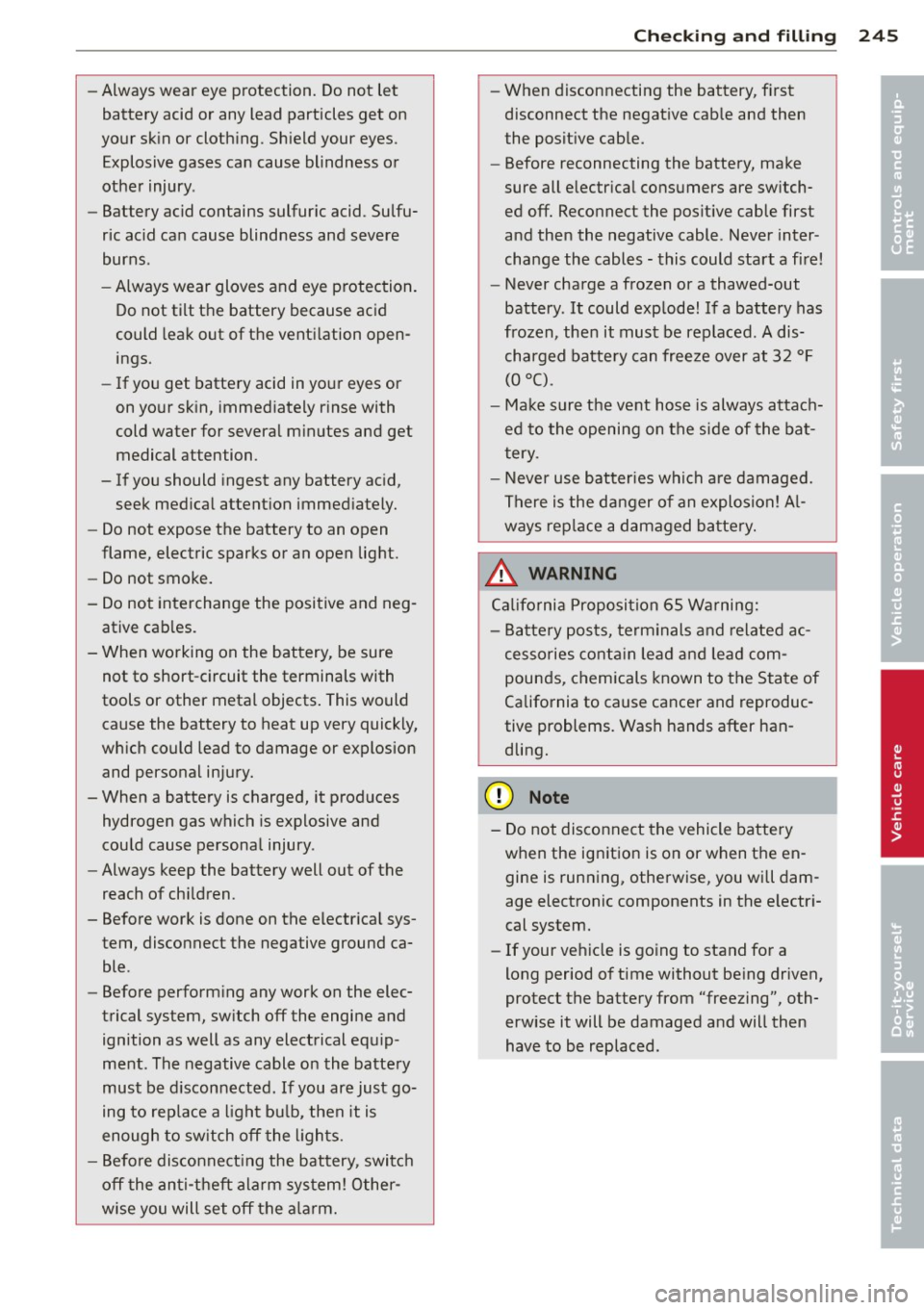
-Always wear eye protection. Do not let
battery acid or any lead particles get on
your skin or clothing. Shield your eyes .
Explosive gases can cause blindness or
other injury.
- Battery acid contains sulfuric acid . Sulfu
ric acid can cause blindness and severe
burns.
- Always wear gloves and eye protection.
Do not tilt the battery because acid
could leak out of the ventilation open
ings.
- If you get battery acid in your eyes or
on your skin, immediately rinse with
cold water for several minutes and get
medical attention .
- If you should ingest any battery acid,
seek medical attention immediately.
- Do not expose the battery to an open
flame, electric sparks or an open light.
- Do not smoke.
- Do not interchange the positive and neg-
ative cables .
= When working on the battery, be sure
not to short-circuit the terminals with
tools or other metal objects. This would cause the battery to heat up very quickly,
which could lead to damage or explosion and personal injury.
- When a battery is charged, it produces
hydrogen gas which is explosive and
could cause personal injury .
- Always keep the battery well out of the
reach of children.
- Before work is done on the electrical sys
tem, disconnect the negative ground ca ble .
- Before performing any work on the elec
trical system, switch off the engine and
ignition as well as any electrical equip
ment. The negative cable on the battery
must be disconnected . If you are just go
ing to replace a light bulb, then it is
enough to switch off the lights.
- Before disconnecting the battery, switch
off the anti-theft alarm system! Other
wise you will set off the alarm.
Checking and filling 245
-When disconnecting the battery, first
disconnect the negative cable and then
the positive cable.
- Before reconnecting the battery, make
sure all electrical consumers are switch
ed off. Reconnect the positive cable first
and then the negative cable . Never inter
change the cables -this could start a fire!
- Never charge a frozen or a thawed-out
battery . It could explode! If a battery has
frozen , then it must be replaced . A dis
charged battery can freeze over at 32 °F
(0 °C) .
-Make sure the vent hose is always attach
ed to the opening on the side of the bat
tery .
- Never use batteries which are damaged.
There is the danger of an explosion! Al
ways replace a damaged battery.
&_ WARNING
California Proposition 65 Warning:
- Battery posts, terminals and related ac
cessories contain lead and lead com
pounds, chemicals known to the State of
California to cause cancer and reproduc
tive problems. Wash hands after han dling.
(D Note
- Do not disconnect the vehicle battery
when the ignition is on or when the en gine is running, otherwise, you will dam
age electronic components in the electri
cal system.
- If your vehicle is going to stand for a
long period of time without being driven,
protect the battery from "freezing", oth
erwise it will be damaged and will then
have to be replaced.
•
•
Page 249 of 318

CD Note
Never use a fast charger as a booster to
start the engine . This will seriously dam
age sensitive electronic components, such
as control units, relays, radio, etc ., as well
as the battery charger .
Battery replacement
The new battery must have the same specifi
cations and dimensions as the original equip
ment battery .
Intelligent energy management in your vehi
cle is responsible for d istributing the electr i
cal energy throughout your vehicle
c::> page 203 . The intelligent energy manage
ment system w ill keep the engine battery
charged bette r than vehicles w ithout t his sys
tem. To make sure the additional electr ica l en
ergy is available once again after you have
changed the battery, we recommend that you
install batteries of the same type and manu
facture only (the same as those installed at
the time your vehicle was delivered). Specifi
cations are listed on the bat tery hous ing. Your
author ized dealer must code the battery in
the energy management system to enable you
to use the energy management functions cor
rectly after replac ing the battery .
T he new battery must have the same capacity ,
voltage (12 volts), amperage, construction and p lug sealing.
When installing the battery, make sure the ig
n ition and all electr ical consumers are sw itch
ed off .
CD Note
-Make sure the ventilat ion hose on the
s ide of the battery is connected, other
wise fumes or battery acid can leak out.
- Vehicles with the Start-Stop-System* are
equipped with a special cycle-proof AGM
battery. Insta lling a different type of
batte ry can cause prob lems in the vehi
cle elect rical system. When replacing the
vehicle battery, always insta ll one wi th
Checkin g and fillin g 247
the same specifications as the origina l
battery .
- Battery mounts and clamps must always
be sec ured correct ly .
- Read and fo ll ow the warnings under
c::> page 244, Working on the battery be
fore performing any work on the battery.
@ For the sake of the environment
Because of the prob lem of p roper disposal
of a ba ttery, we recommend your author
ized Audi dealer change the battery for
you. Batteries contain sulfuric acid and l ead and must always be disposed of prop
erly in compliance with all environmental
regulat ions. Disposing of vehicle batter ies
i mproperly is very dangerous to the envi
r o nment .
Windshield/headlight
washer container
.., N
-N
" ~
Fig. 203 Eng in e compa rtm ent: cove r on the w inds hield
washer flu id rese rvo ir
T he washer fluid container is marked w ith the
symbol-$ on its cap
c::>fig. 203, c::>page 234.
.,. Before you check anything in the engine
compa rtment, always read and heed all
WARNINGS c::> A in Working in the engine
compartment on page 232.
.,. Lift the filler cap tongue to add washer flu
id. You can fi ll the container to the top .
.,. Press the cap back onto the f iller neck after
filling the container .
You can find the reservoir capacity in the table
inc::>page292. ""
•
•